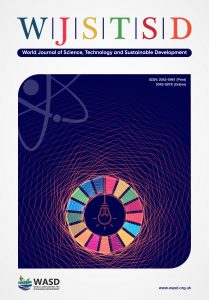Effect of decortication methods on the chemical composition, antinutrients, Ca, P and Fe contents of two pearl millet cultivars during storage, Elfadil Babiker, Babiker Abdelseed, Hayat Hassan and Oladipupo Adiamo
 Elfadil Babiker, Oladipupo Adiamo
Elfadil Babiker, Oladipupo Adiamo
Department of Food Science and Nutrition, College of Food and Agricultural Sciences
King Saud University, Riyadh
Saudi Arabia
Email: ebabiker.c@ksu.edu.sa
Babiker Abdelseed, Hayat Hassan
Department of Grain Technology, Ministry of Agriculture
Food Research Center, Khartoum North
Sudan
DOI: 10.1108/WJSTSD-01-2018-0005
Purpose: The purpose of this paper is to evaluate the impact of modern and traditional decortication methods on the chemical composition, antinutrients, Ca, P and Fe contents during storage of two pearl millet cultivars (white and green) grown in Sudan.
Design/methodology/approach: The grains of each cultivar were either decorticated traditionally using traditional stone dehuller or by using modern dehuller. The chemical composition, antinutrients and Ca, P and Fe contents of the cultivars were evaluated during storage for six months.
Findings: The results showed that both methods of decortication (modern and traditional) employed significantly decreased ash, protein, oil and crude fiber contents but increased moisture and nitrogen free extract contents of the grains for both cultivars. Storage resulted in a slight and gradual decrease in the chemical composition of the treated and untreated grains of the cultivars. Modern decortication of the grains significantly (P=0.05) reduced tannin content in both cultivars compared to untreated and traditionally decorticated grains. Phytic acid content of the white cultivar was not affected by the method of decortication used but modern decortication reduced that of green cultivar. Decrease in tannin and phytic acid was observed as the storage continued in both treated and untreated cultivars. Decortication significantly (P=0.05) reduced the Ca, P and Fe contents in both cultivars grains. Lower P and Fe contents were found in modern decorticated grains compared to traditional decorticated ones. Storage of the cultivars resulted in gradual decrease in Ca, P and Fe contents.
Research limitations/implications: Processing methods such as decortication affect the quality attributes of pearl millet cultivars. The application of modern decortication method on pearl millet cultivars has better quality attributes than those treated with traditional decortication.
Originality/value: The study uses decortication methods (traditional and modern) to improve the quality attributes of pearl millet cultivars. Antinutrients such as tannin and phytic acid were observed to reduce the bioavailability of minerals like Fe. Decortication of the grains significantly reduced the level of such antinutrients and improved bioavailability of minerals.
Keywords: Antinutrients; Pearl millet; Chemical composition; Decortications; Mineral contents.
Citation: Babiker, E., Abdelseed, B., Hassan, H. and Adiamo, O. (2018), "Effect of decortication methods on the chemical composition, antinutrients, Ca, P and Fe contents of two pearl millet cultivars during storage", World Journal of Science, Technology and Sustainable Development, Vol. 15 No. 3, pp. 278-286. https://doi.org/10.1108/WJSTSD-01-2018-0005

